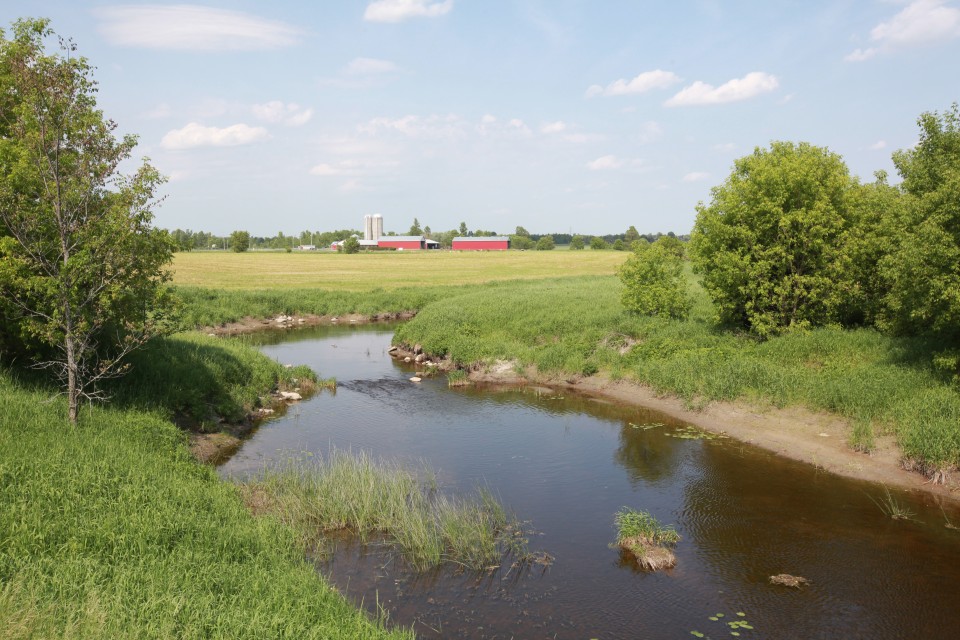Highlights
- As of September 1st, 2021, proAction's Environment module is in effect.
- Between 2011 and 2016, Canadian dairy farmers reduced the amount of land needed to produce a litre of milk by 11%, through improved land management practices.
Perhaps you have spotted it when enjoying your favourite food or beverage – the Dairy Farmers of Canada ‘Blue Cow’ logo, which makes it easy to identify products made with 100% Canadian milk and dairy ingredients.
When you buy products marked with the Blue Cow, you’re not just supporting the local economy and ensuring your milk comes from Canadian farms. Behind the logo is a robust quality assurance program called proAction®, which assures that Canadian milk is produced responsibly, under some of the world’s most stringent standards.
Farmers follow a comprehensive set of requirements and best practices in areas like milk quality, food safety, animal welfare, biosecurity and livestock traceability, to ensure the exceptional quality of Canadian milk. It also assures you, the consumer, that Canadian milk is produced responsibly by farmers that care!
Raising the Bar on Sustainability
This fall, dairy farmers are taking their commitments under proAction to the next level, with the introduction of the sixth module, focusing on environmental sustainability.
Dairy farmers have always been deeply invested in the sustainability of their farms, their animals, and their land. Farmers are motivated to run their farms in the most efficient and sustainable way possible, because it's the right thing to do!
We're proud to say that Canadian milk production already has one of the lowest carbon footprints in the world for dairy. And our farmers are not stopping there!
Whether through the sector’s efforts to better track the environmental impact of dairy, our efforts in research and development, or the continued adoption of better farm practices, dairy farmers are as committed as ever to the goal of greater sustainability.
Taking Meaningful Action on our Farms
What are some of the measures being implemented on farms?
A number of dairy farms have installed biodigesters, which convert the methane contained in manure into reusable energy, while continuing to use manure as a natural fertilizer. More are installing solar panels or wind turbines on their land, where the weather conditions are right for it.
Today, farmers are embracing GPS-enabled smart tractors, data collection, computerized models, robotic machinery, and other high-tech farming equipment to increase productivity and reduce their environmental footprint.
What about water? Water plays an important role on dairy farms: it is needed to grow crops, keep cows cool and hydrated, and clean barns and equipment. Thanks to innovative water recycling technologies, Canadian dairy farmers have managed to reduce their water consumption by 6% in recent years.
Between 2011 and 2016, Canadian dairy farmers reduced the amount of land needed to produce a litre of milk by 11%, through improved land management practices. Those include:
- Strategic crop rotations to improve soil health and improve biodiversity;
- Using the most natural kind of fertilizer there is – cow manure – to foster microbial activity in the soil and reduce the need for petroleum-based fertilizers;
- The use of cover crops to help minimize soil erosion, increase fertility and moisture, and control against weeds, pests, and diseases while supporting biodiversity; and
- Adopting reduced or no tillage practices, like leaving stubs and roots of a previous year’s crop in the soil, to help capture more carbon in the soil.
Entrenching our Commitment to a Greener Future: proAction’s Environment Module
Under the new module of proAction, all farms will be required to have an environmental farm plan in place. These highly tailored plans outline some of the specific measures that will be taken on each individual farm! We’re proud to say that even before the new module was introduced, more than 80% of dairy farms already had an environmental farm plan in place. We welcome the opportunity to take this progress one step further!
The new module also includes a benchmarking aspect, to help farm operators identify areas of strength and opportunities for improvement. The data collected through this component will help provide a detailed pan-Canadian snapshot of our progress at the farm-level.
Additional requirements aim to reduce the risk of contamination of soil, groundwater and surface water from wastewater and manure, and to make the best use of manure and other nutrients on the farm.
Protecting our environmental legacy is important to Canadian dairy farmers, and doing more with less means improving productivity, reducing waste, and managing resources responsibly.
Our work is not yet finished, as the program will continue to evolve to reflect the latest research and best practices.
We can’t wait to see what the future has in store!
For more information, please visit dairyfarmers.ca/proaction.
